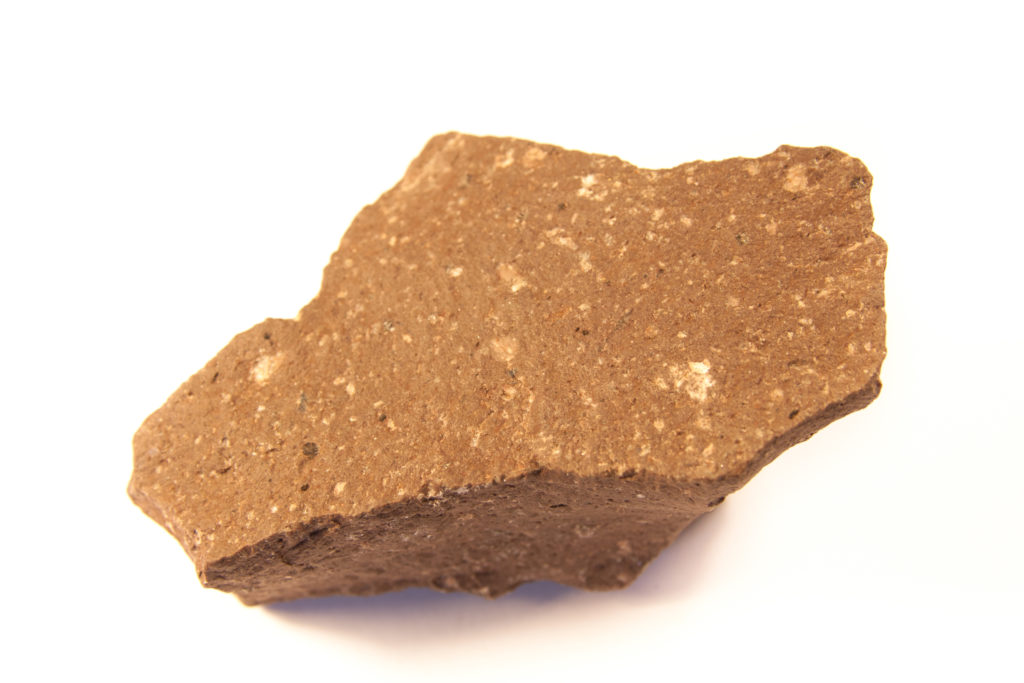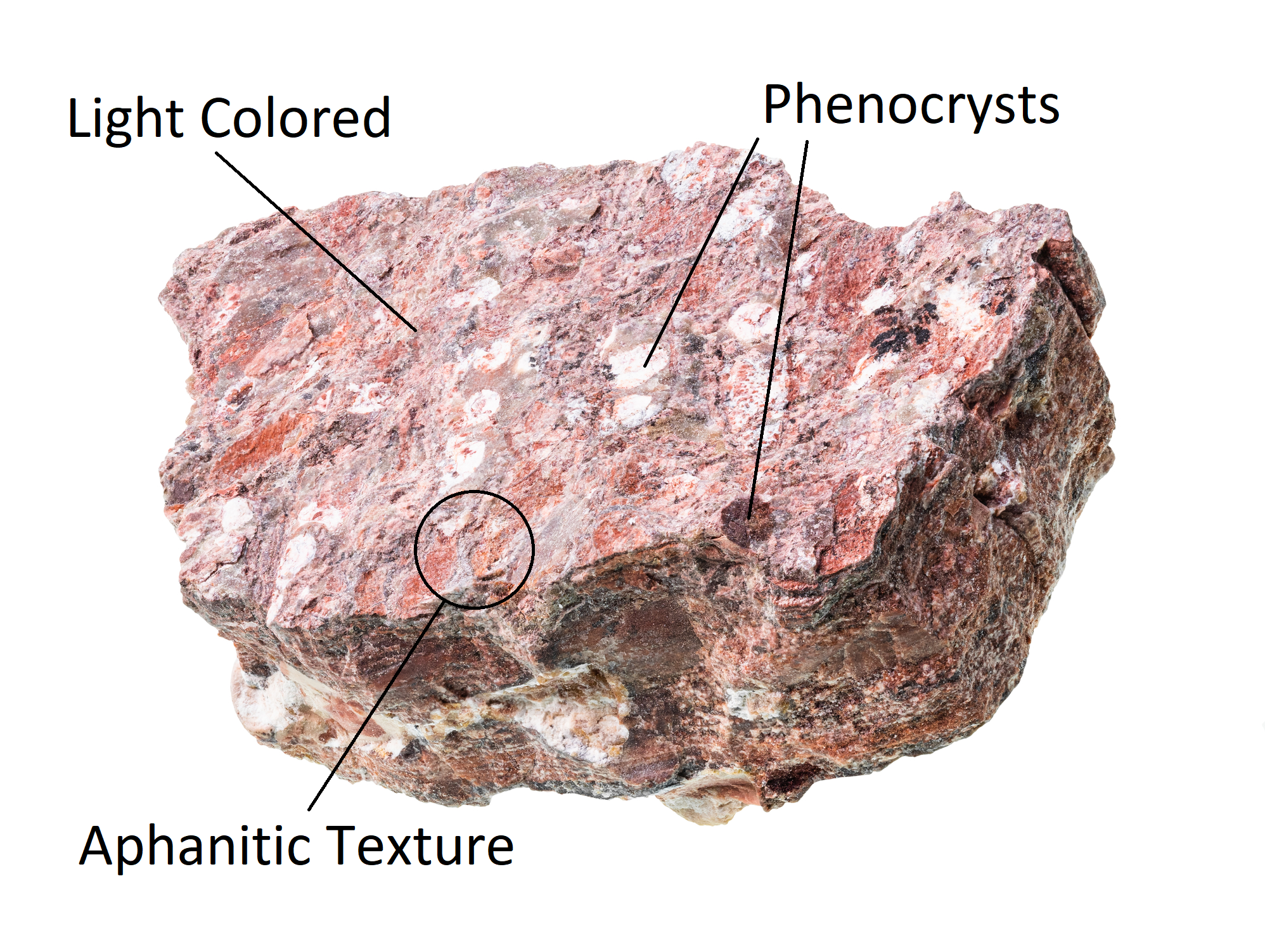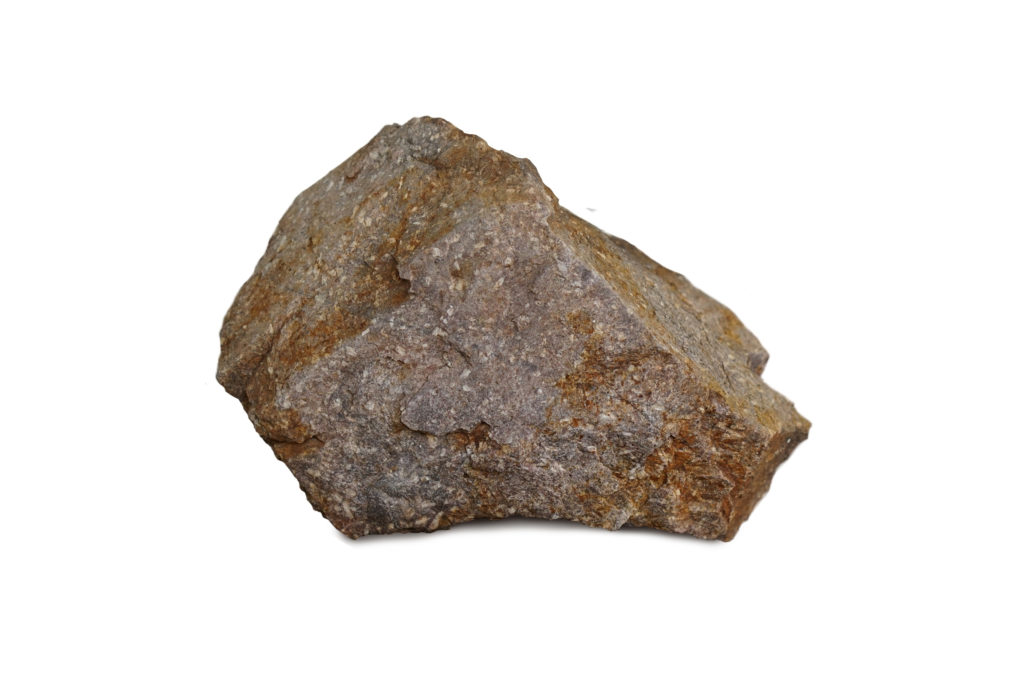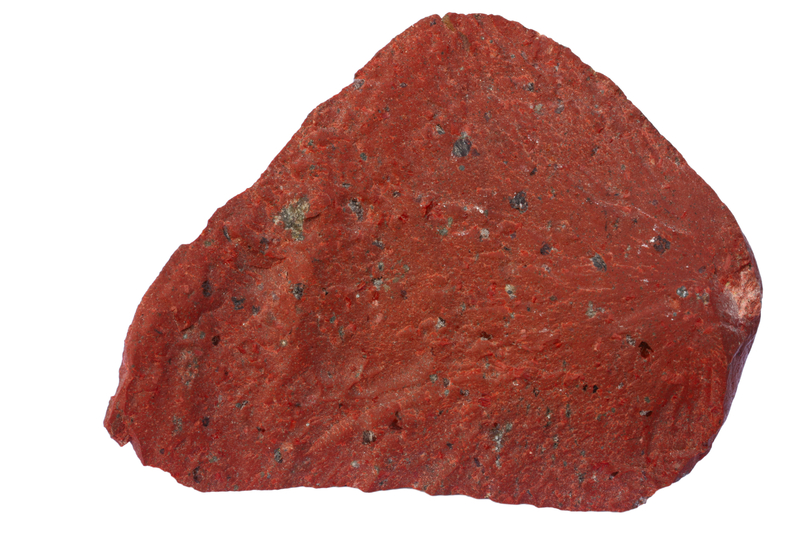Rhyolite is a very common igneous rock that can be found all around the world. It’s one of my favorite rocks because it can come in many different colors and varieties and it often has interesting features like inclusions of larger crystals.
Despite rhyolite’s relative abundance, many people aren’t all that familiar with it. While it can be difficult to know exactly what rhyolite looks like and how to identify it, it is a relatively simple process if you know what to look for.
Rhyolite is an extrusive, aphanitic (fine-grained), light-colored (felsic) igneous rock consisting of between 20-90% quartz, less than 15% dark-colored minerals, and feldspar. Alkali feldspar makes up 35 to 100% of the total feldspar content. Rhyolite may contain some larger crystals know as phenocrysts.
While rhyolite is a clearly defined rock type, there are many different varieties that can appear quite different from one another. I’ll walk you through how to identify rhyolite, what it looks like, and where it can be found.
What Does Rhyolite Look Like?
One of the reasons people have difficulty identifying rhyolite is that it can look fairly nondescript at first glance. As with many aphantic (fine-grained) rocks, it is difficult at first glance to find many identifying features beyond their overall color. So, what exactly does rhyolite look like?
Rhyolite is usually light pink, reddish, light gray, or off-white in color. The bulk of the rock is made of crystal grains too small to see with the naked eye, but there may be larger crystals (phenocrysts) of quartz or feldspar interspersed throughout.

Pro Tip: I have created the best rock identification system you’ll find anywhere. It’s made to help everyone from brand new hobbyists to university Geology students, and includes an eBook, digital tools, a video tutorials. Find out more here!
While all rhyolite meets this general description, there is a pretty wide spectrum of rhyolite that can look significantly different from one another. The difference in their appearance is driven by the mineralogy of each type of rhyolite and, to a lesser extent, the subtle differences in their textures (crystal sizes).
Color is Driven by Mineralogy
The two major minerals present in all rhyolite are quartz and feldspar. Each of these minerals can present itself in different ways. Feldspar, in particular, can look quite different from rock to rock depending on the specific type of feldspar that is present (alkali or plagioclase).
Quartz usually appears in rhyolite as light gray, or off-white. Most of the quartz crystals are too small to see with the naked eye, but there may be some larger quartz phenocrysts present. These phenocrysts may be translucent, but they are usually the typical off-white or gray you see in the rest of the rock. In any case, quartz is a significant contributor to rhyolite’s overall light color.
Feldspar has much more variety than quartz. It is actually a group of minerals that can be divided into two main types: plagioclase feldspar and alkali feldspar. These two types of feldspar look quite different from one another, and can even vary significantly in appearance themselves. More than one type of feldspar may be present in rhyolite.
Alkali is usually more abundant in rhyolite than plagioclase, but both are common. For the purposes of identifying a rock as rhyolite, distinguishing between the two is usually not necessary. However, there are some easy-to-spot differences that can help you see the difference and further understand your rock.
Pro Tip: To get a better look at the crystals in your rocks and help with identification I highly recommend picking up a good geologist’s hand lens. I use this one that I got on Amazon.
Both alkali and plagioclase feldspar can be white, but alkali is also very commonly salmon-pink or even darker pink, bordering on red. Plagioclase feldspar usually has visible striations in its crystals that may be visible if the individual crystals are large enough.
The most common accessory minerals (minerals found in relatively low amounts) in rhyolite are mica and amphibole. The micas will either be muscovite or biotite, both of which form very flaky ‘books’ as crystals in the rock. Muscovite is very light or even translucent, while biotite is very dark. Amphibole is a large group of minerals, but they will always contribute a darker color to the rock. These mafic accessory minerals usually don’t form large enough crystals to see with the naked eye in rhyolite.
Texture of Rhyolite
One of the defining features of rhyolite’s appearance is its texture. All rhyolites are fine-grained, meaning that you cannot see the individual crystals in the rock matrix. This texture is known as ‘aphanitic’, and it forms when lava cools relatively quickly on the Earth’s surface, denying the crystals enough time to grow before becoming completely solidified.
While all rhyolites are aphanitic, it is also possible (and even common) to describe their texture in other ways. Rocks can be described as having more than one texture as long as the texture types are not mutually exclusive.
Many rhyolites are ‘porphyritic‘, which means that there are larger crystals encased in the main, fine-grained mass of the rock. These larger crystals are called phenocrysts, and they can easily be seen with the naked eye. So, a rhyolite rock may be described as ‘aphanitic and porphyritic’ if most of the rock is fine-grained but with visible crystals interspersed throughout.
How to Identify Rhyolite
Rhyolite is so widespread and relatively recognizable that you might think that identifying it is a trivial matter. While that is often the case, that mindset often leads people to misidentify other rock types as rhyolite. It is important to take a more methodical approach when identifying rhyolite.
To identify rhyolite, first ensure its color is relatively light – usually light pink or light gray. Then, note that the crystals in the mass of the rock cannot be seen with the naked eye. Some larger crystals may be identifiable as quartz or feldspar. Rhyolite is dense, with no bubbles or air pockets.
A rock must meet all of these requirements to be considered a rhyolite:
- Igneous – Formed from cooling lava, with interlocking crystal grains.
- Fine-grained – Aphanitic or porphyritic texture with crystals invisible to the naked eye
- Felsic Mineralogy – High quartz and feldspar content
- Massive – No internal structures or layering

If your rock meets all of those criteria then it is very likely a rhyolite, or at least something very closely related. Some fine-grained rocks with mineralogies very similar to granite and rhyolite are considered ‘granitoids’, and for purposes of casual identification ‘rhyolite’ is usually close enough.
Tip: This article is part of my igneous rock identification series. To read more about how to identify all igneous rocks, check out my article here.
What Is Rhyolite Made Of?
As I mentioned above, rhyolite is largely defined by specific mineralogy. All rocks are made from one or more minerals, and in order to fully understand a rock like rhyolite, you have to know what those minerals are.
Rhyolite is made from large amounts of quartz and alkali feldspar, with smaller amounts of plagioclase feldspar. The mineral composition of rhyolite consists of 20% to 60% quartz, and 35% to 90% of the total feldspar must be alkali feldspar. Dark, mafic minerals make up less than 15% of the rock volume.

It is worth noting that this mineralogy is the exact same definition as granite. This is because rhyolite is the extrusive equivalent of granite, meaning that they are made of the exact same stuff just with different crystal sizes. Granite forms when magma cools slowly inside the earth, allowing time for larger crystals to grow, while rhyolite cools more rapidly on the surface.
While this mineralogical definition is very specific, most rhyolite-like rocks do end up falling into this category. Without sophisticated methods for measuring mineral types and percentages, it is impractical (or even impossible) for us to determine if a rhyolite-like rock falls into those specific percentage ranges, so it is sufficient to call anything reasonably close a ‘rhyolite’.
Where Is Rhyolite Found?
Rhyolite is an extremely common rock that can be found in localities all around the world. The magma type from which it forms is often found in a specific but relatively common geologic setting, making rhyolite (and its cousin granite) some of the more abundant igneous rock types you can find.
Rhyolite is usually found near convergent plate boundaries where eruptions of felsic lava are common, such as in the western states of the U.S. It is formed when silica-rich magma cools on the Earth’s surface after violent volcanic eruptions.
Because rhyolite is made of hard, durable minerals like quartz and feldspar it is pretty common to find it in rivers and streams far away from where they were originally formed. When rhyolite is eroded it can find its way into a river and survive a great deal of weathering over time.
How Does Rhyolite Form?
We’ve learned all about what rhyolite looks like, what it is composed of, and generally where it’s found, but I have only briefly touched on how it’s actually formed. The creation of rhyolite is a fascinating process that always follows a few simple rules but can vary significantly in the details, which is the reason rhyolite can look so different from one sample to another.
Rhyolite forms from the rapid cooling of felsic, silica-rich magma above the Earth’s surface. The interaction of the lava with the relatively cool air and surface allows only enough time for the formation of very small crystals of quartz, feldspar, and accessory minerals like amphibole and mica.
Because the composition of the source magma is never exactly the same from one rhyolite to another and the surrounding environment is always different, there can be quite a lot of variation in how the magma cools and the crystals form.
The magma/lava from which rhyolite forms can undergo more than one cooling phase, often resulting in a porphyritic texture. The magma may remain below the surface and allow for relatively large crystals (the phenocrysts) to form before being erupted to the surface where the more rapid cooling of the remainder of the lava occurs.
As the individual crystals of rhyolite’s various minerals cool down, they eventually run into each other and they run out of room. Crystallization will continue until all of the magma is solidified, leaving behind interlocking crystals with virtually no porosity between them.
Because rhyolite forms as one solid mass, it contains no internal structures like bedding or banding. It looks the same from all directions and you can’t tell which direction was ‘up’ at the time of crystallization. This is called a ‘massive’ rock.

What Is Rhyolite Used For?
Rhyolite has been in use for thousands of years because of its durability, strength, prevalence, and striking appearance.
Rhyolite is most commonly used for interior and exterior building applications. Highly polished rhyolite is an extremely popular material for countertops, while rough-cut rhyolite is one of the most prevalent choices for outdoor construction. Polished rhyolite is also very popular for jewelry making.
Like most rocks, rhyolite is very strong in compression. This means it can withstand a great deal of ‘squeezing’ without breaking, making it ideal for use in construction projects with large overburden stresses.
Similar to granite, what really sets rhyolite apart is its ability to accept a polish and its resistance to weathering. The highly polished rhyolite countertops you’re used to seeing are made possible by the fact that quartz and feldspar are easily brought to a high shine. One of the biggest reasons granite is so popular as a building material is because it doesn’t break down in the rain, ice, and wind as easily as other rocks.
A particularly unique feature of rhyolite is the possibility of ‘thundereggs’. These nodule-like rocks form in rhyolitic ash layers and are very beautiful when cut in half, displaying star-shaped interiors made of attractive varieties of agate, jasper, or opal. Thundereggs are a very popular item with rock and mineral collectors.
This article is part of my rock identification series. To learn more about identifying rocks, check out my full in-depth guide here.
